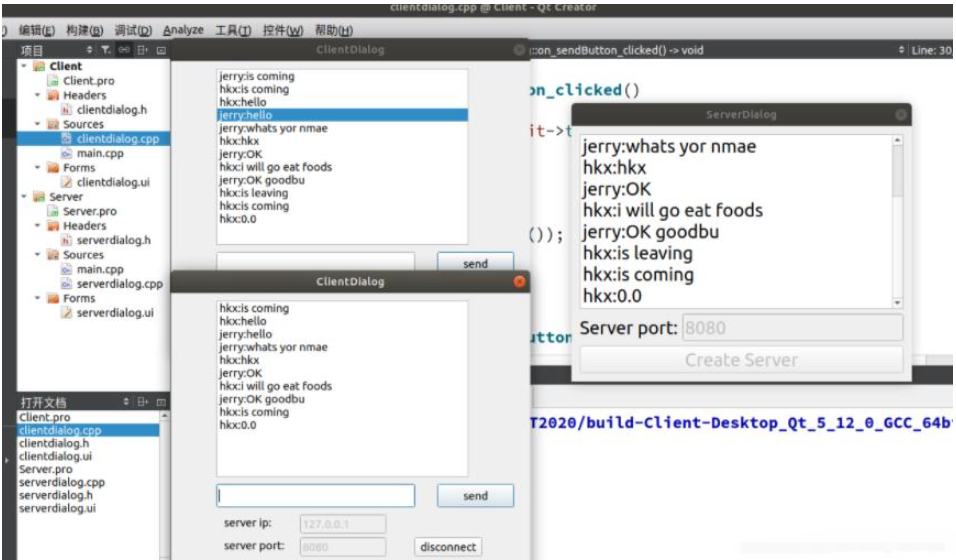溫馨提示×
您好,登錄后才能下訂單哦!
點擊 登錄注冊 即表示同意《億速云用戶服務條款》
您好,登錄后才能下訂單哦!
今天小編給大家分享一下怎么用QT實現TCP網絡聊天室的相關知識點,內容詳細,邏輯清晰,相信大部分人都還太了解這方面的知識,所以分享這篇文章給大家參考一下,希望大家閱讀完這篇文章后有所收獲,下面我們一起來了解一下吧。
serverdialog.h
#ifndef SERVERDIALOG_H
#define SERVERDIALOG_H
#include <QDialog>
#include <QTcpServer>
#include <QTcpSocket>
#include <QDebug>
#include <QTimer>
namespace Ui {
class ServerDialog;
}
class ServerDialog : public QDialog
{
Q_OBJECT
public:
explicit ServerDialog(QWidget *parent = 0);
~ServerDialog();
private slots:
//創建服務器按鈕對應的槽函數
void on_pushButton_clicked();
//響應客戶端連接請求的槽函數
void onNewConnection();
//接收客戶端聊天消息的槽函數
void onReadyRead();
//轉發聊天消息給其它客戶端的槽函數
void sendMessage(const QByteArray&);
//定時器檢查客戶端套接字是否為正常連接狀態的槽函數
void onTimeout(void);
private:
Ui::ServerDialog *ui;
QTcpServer tcpServer;//TCP服務器
quint16 port;//服務器端口,quint16-->unsigned short
QList<QTcpSocket*> tcpClientList;//容器:保存和客戶端通信的套接字
QTimer timer;//定時器,定時檢查容器中和客戶端通信的套接字是否為正常連接狀態
};
#endif // SERVERDIALOG_Hserverdialog.cpp
#include "serverdialog.h"
#include "ui_serverdialog.h"
ServerDialog::ServerDialog(QWidget *parent) :
QDialog(parent),
ui(new Ui::ServerDialog)
{
ui->setupUi(this);
}
ServerDialog::~ServerDialog()
{
delete ui;
}
//創建服務器按鈕對應的槽函數
void ServerDialog::on_pushButton_clicked()
{
//獲取服務器端口
port = ui->lineEdit->text().toShort();
//設置監聽服務器的IP和端口
//QHostAddress::Any ==> QHostAddress("0.0.0.0");
if(tcpServer.listen(QHostAddress::Any,port)==false){
qDebug() << "創建服務器失敗";
return;
}
else{
qDebug() << "創建服務器成功";
//當有客戶端向服務器發送連接請求時,發送信號newConnection
connect(&tcpServer,SIGNAL(newConnection()),
this,SLOT(onNewConnection()));
//禁用端口輸入和創建服務器按鈕
ui->lineEdit->setEnabled(false);
ui->pushButton->setEnabled(false);
//定時器到時發送信號:timeout
connect(&timer,SIGNAL(timeout()),this,SLOT(onTimeout()));
//開啟定時器,每隔3秒檢查一次
timer.start(3000);
}
}
//響應客戶端連接請求的槽函數
void ServerDialog::onNewConnection()
{
//獲取和客戶端通信的套接字
QTcpSocket* tcpClient = tcpServer.nextPendingConnection();
//保存套接字到容器中
tcpClientList.append(tcpClient);
//當客戶端給服務器發送消息時,tcpClient發送信號readyRead
connect(tcpClient,SIGNAL(readyRead()),
this,SLOT(onReadyRead()));
}
//接收客戶端聊天消息的槽函數
void ServerDialog::onReadyRead()
{
//遍歷檢查哪個客戶端有消息
for(int i=0;i<tcpClientList.size();i++){
//at(i):獲取容器中第i套接字(QTcpSocket*)
//bytesAvailable:獲取當前套接字等待讀取消息的字節數,如果為0表示沒有消息,如果
//大于0說明有消息.
if(tcpClientList.at(i)->bytesAvailable()){
//讀取消息并保存
QByteArray buf = tcpClientList.at(i)->readAll();
//顯示消息
ui->listWidget->addItem(buf);
//回滾到最底部(最新消息)
ui->listWidget->scrollToBottom();
//轉發消息給其它客戶端
sendMessage(buf);
}
}
}
//轉發聊天消息給其它客戶端的槽函數
void ServerDialog::sendMessage(const QByteArray& msg)
{
for(int i=0;i<tcpClientList.size();i++){
tcpClientList.at(i)->write(msg);
}
}
//定時器檢查客戶端套接字是否為正常連接狀態的槽函數
void ServerDialog::onTimeout(void)
{
for(int i=0;i<tcpClientList.size();i++){
//state():獲取第i個套接字的連接狀態
//UnconnectedState:表示未連接(斷開連接)
if(tcpClientList.at(i)->state() ==
QAbstractSocket::UnconnectedState){
//從容器中將斷開連接的套接字移除
tcpClientList.removeAt(i);
--i;
}
}
}main.cpp
#include "serverdialog.h"
#include <QApplication>
int main(int argc, char *argv[])
{
QApplication a(argc, argv);
ServerDialog w;
w.show();
return a.exec();
}clientdialog:
#ifndef CLIENTDIALOG_H
#define CLIENTDIALOG_H
#include <QDialog>
//QT += network
#include <QTcpSocket>
#include <QHostAddress>
#include <QMessageBox>
namespace Ui {
class ClientDialog;
}
class ClientDialog : public QDialog
{
Q_OBJECT
public:
explicit ClientDialog(QWidget *parent = 0);
~ClientDialog();
private slots:
//發送按鈕對應的槽函數
void on_sendButton_clicked();
//連接服務器按鈕對應的槽函數
void on_connectButton_clicked();
//和服務器連接成功時執行的槽函數
void onConnected(void);
//和服務器斷開連接時執行的槽函數
void onDisconnected(void);
//接收服務器轉發聊天消息的槽函數
void onReadyRead(void);
//網絡通信異常時執行的槽函數
void onError(void);
private:
Ui::ClientDialog *ui;
bool status;//客戶端狀態標記,true:在線,false:離線狀態
QTcpSocket tcpSocket;//和服務器通信的tcp套接字
QHostAddress serverIp;//服務器地址
quint16 serverPort;//服務器端口
QString username;//聊天室昵稱
};
#endif // CLIENTDIALOG_Hclientdialog.cpp
#include "clientdialog.h"
#include "ui_clientdialog.h"
ClientDialog::ClientDialog(QWidget *parent) :
QDialog(parent),
ui(new Ui::ClientDialog)
{
ui->setupUi(this);
status = false;
//和服務器連接成功時,tcpSocket發送信號:connected
connect(&tcpSocket,SIGNAL(connected()),
this,SLOT(onConnected()));
//和服務器斷開連接時,tcpSocket發送信號:disconnected
connect(&tcpSocket,SIGNAL(disconnected()),
this,SLOT(onDisconnected()));
//收到聊天消息時,tcpSocket發送信號:readyRead
connect(&tcpSocket,SIGNAL(readyRead()),
this,SLOT(onReadyRead()));
//網絡通信異常時,tcpSocket發送信號:error
connect(&tcpSocket,SIGNAL(error(QAbstractSocket::SocketError)),
this,SLOT(onError()));
}
ClientDialog::~ClientDialog()
{
delete ui;
}
//發送按鈕對應的槽函數
void ClientDialog::on_sendButton_clicked()
{
//獲取用戶輸入的消息
QString msg = ui->messageEdit->text();
if(msg == ""){
return;
}
msg = username + ":" + msg;
//發送消息
tcpSocket.write(msg.toUtf8());
//清空已輸入的消息
ui->messageEdit->clear();
}
//連接服務器按鈕對應的槽函數
void ClientDialog::on_connectButton_clicked()
{
if(status == false){//如果當前是離線狀態,則連接服務器
//獲取服務器IP
if(serverIp.setAddress(ui->serverIpEdit->text())==false){
//critical():表示錯誤的消息提示框
QMessageBox::critical(this,"Error","IP地址錯誤");
return;
}
//獲取服務器端口
serverPort = ui->serverportEdit->text().toShort();
if(serverPort < 1024){
QMessageBox::critical(this,"Error","端口格式錯誤");
return;
}
//獲取聊天室昵稱
username = ui->usernameEdit->text();
if(username == ""){
QMessageBox::critical(this,"Error","聊天室昵稱不能為空");
return;
}
//向服務器發送連接請求:
//如果成功,發送信號:connected;
//如果失敗,發送信號:error
tcpSocket.connectToHost(serverIp,serverPort);
}
else{//如果當前是在線狀態,則斷開和服務器連接
//向服務器發送離開聊天室的消息
QString msg = username + ":離開了聊天室";
//toUtf8():將QString(unicode)轉換QByteArray(utf-8)
tcpSocket.write(msg.toUtf8());
//斷開連接
//斷開后發送信號:disconnected
tcpSocket.disconnectFromHost();
}
}
//和服務器連接成功時執行的槽函數
void ClientDialog::onConnected(void)
{
status = true;//設置狀態標記:在線
ui->sendButton->setEnabled(true);//恢復"發送"按鈕為正常可用狀態
ui->serverIpEdit->setEnabled(false);//禁用ip輸入
ui->serverportEdit->setEnabled(false);//禁用端口輸入
ui->usernameEdit->setEnabled(false);//禁用昵稱輸入
ui->connectButton->setText("離開聊天室");//修改連接服務器按鈕文本
//向服務器發送進入聊天室提示消息
QString msg = username + ":進入了聊天室";
//toUtf8():將QString(unicode)轉換QByteArray(utf-8)
tcpSocket.write(msg.toUtf8());
}
//和服務器斷開連接時執行的槽函數
void ClientDialog::onDisconnected(void)
{
status = false;//設置離線狀態
ui->sendButton->setEnabled(false);//禁用"發送"按鈕
ui->serverIpEdit->setEnabled(true);//恢復ip輸入
ui->serverportEdit->setEnabled(true);//恢復端口輸入
ui->usernameEdit->setEnabled(true);//恢復昵稱輸入
ui->connectButton->setText("連接服務器");//修改離開聊天室按鈕文本
}
//接收服務器轉發聊天消息的槽函數
void ClientDialog::onReadyRead(void)
{
//bytesAvailable():獲取等待讀取消息的字節數
if(tcpSocket.bytesAvailable()){
//讀取消息
QByteArray buf = tcpSocket.readAll();
//顯示消息到界面
ui->listWidget->addItem(buf);
ui->listWidget->scrollToBottom();
}
}
//網絡通信異常時執行的槽函數
void ClientDialog::onError(void)
{
//errorString():獲取網絡通信異常原因的字符串
QMessageBox::critical(this,"Error",tcpSocket.errorString());
}main.cpp
#include "clientdialog.h"
#include <QApplication>
int main(int argc, char *argv[])
{
QApplication a(argc, argv);
ClientDialog w;
w.show();
return a.exec();
}最終實現效果:

以上就是“怎么用QT實現TCP網絡聊天室”這篇文章的所有內容,感謝各位的閱讀!相信大家閱讀完這篇文章都有很大的收獲,小編每天都會為大家更新不同的知識,如果還想學習更多的知識,請關注億速云行業資訊頻道。
免責聲明:本站發布的內容(圖片、視頻和文字)以原創、轉載和分享為主,文章觀點不代表本網站立場,如果涉及侵權請聯系站長郵箱:is@yisu.com進行舉報,并提供相關證據,一經查實,將立刻刪除涉嫌侵權內容。